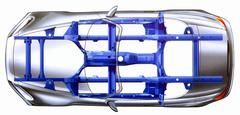Honda S2000
Chris Mellor revisits Honda's rev-happy roadster -- an ingeniously fast but quirky little number

We first road-tested Honda’s S2000 in 2002, since when there's been a 2004 refresh. The changes from the initial model are subtle, and in some ways make the car a worse ownership prospect, in other ways better. Has the update changed the character of the car, and is it still a car you'd want to own? And what's the technology that makes it all work?
Let's start with the centrepiece of the car, its engine.
Fibre-reinforced metal
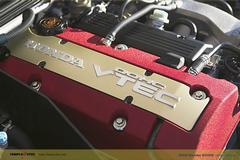 As is well-known, the Honda engine revs up to a 9,000rpm limit. At such high revs, the pistons will be doing a super job of abrading the cylinder walls. Other sportscar engine makers have used Alusil and Nikasil liners -- Porsche for example -- to counteract this.
As is well-known, the Honda engine revs up to a 9,000rpm limit. At such high revs, the pistons will be doing a super job of abrading the cylinder walls. Other sportscar engine makers have used Alusil and Nikasil liners -- Porsche for example -- to counteract this.
Honda didn’t. Instead it went for fibre-reinforced metal, where the cylinder cores are made up of a combination of alumina and carbon fibres. When the cylinder metal is molten during casting these cores absorb some of the aluminium. Then the block is cooled and the cores bored out, leaving behind a cylinder wall sleeve, about 0.5mm thick, of aluminium reinforced with alumina and carbon fibres. It is extremely tough, smooth and hard wearing.
Honda first used this in its NSX supercar. It produces less friction with aluminium pistons than if they reciprocated in pure aluminium cylinders, adding to the engine's rev-happy nature. The fibre sleeve also reinforces the block enabling thinner gaps between the cylinders, helping to make the engine smaller and lighter.
The S2000 has no scuttle shake, that bane of soft tops, because it uses what Honda calls an X-bone frame. (see picture). It's extremely rigid chassis, the centrepiece of which is a box-section central tunnel. From it, two diagonally projecting arms at the front connect to side rails and support the rear of the engine. Also two diagonally-projecting arms at the rear are fixed to a rear transverse rail. The diagonal arms and central tunnel form the X-bone shape.
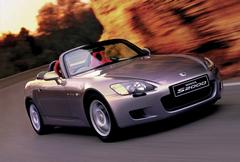 The top of the centre tunnel and the front and rear longitudinal rails form a horizontal plane; these components are all at the same height. This height -- the centre line rigidity height -- is said to be at the same height as the centre-line rigidity of closed roof – coupé and saloon – cars.
The top of the centre tunnel and the front and rear longitudinal rails form a horizontal plane; these components are all at the same height. This height -- the centre line rigidity height -- is said to be at the same height as the centre-line rigidity of closed roof – coupé and saloon – cars.
Generally, convertibles have added reinforcing to compensate for the stiffness lost when the roof is chopped off, the downside of which is extra weight. The trick Honda has managed to achieve is to get an open-topped car’s rigidity up without using whacking great deep side sills and a heavily strengthened floor pan. It's the same rigidity as a closed-roof car without such additional reinforcing and weight, says Honda.
The front and side chassis members are made from high-tensile steel and are straight, not curved. There are deep side sills connecting to the front transverse rails at the same points as the centre tunnel X-bone arms. But the sills are lower than the X-bone frame and thus don’t impede cabin entry space too much.
A side floor member runs back from here to the rear transverse rail which is part of a rear transverse frame. The result is a strong passenger cell. This is helped by a cross member in the passenger cell which distributes energy to the central tunnel in the case of a side impact. Passengers may notice this as there is a pronounced well in the cabin floor ahead of it.
There's also a tube-section brace strengthening the windscreen frame, while the roll-over hoops behind the seats also have internal strengthening, and are fixed to the chassis structure.
The net effect is that the car is said to have the torsional rigidity of a coupe. It’s also said to have better bending rigidity than either a coupe or a convertible.
More for comfort than speed
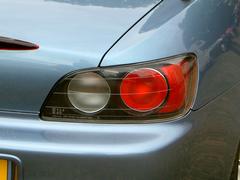 In North America, the S2000 received a 2.2 litre engine for the 2004 model year -- actually 2.157cc. Honda lengthened the stroke to add capacity, the bore and stroke numbers being 87.0 mm x 90.7 mm respectively. Stroked engines typically don't rev as high as their unstroked equivalents because of increased piston speed resulting from the stroke increase but usually produce more torque, as this one does.
In North America, the S2000 received a 2.2 litre engine for the 2004 model year -- actually 2.157cc. Honda lengthened the stroke to add capacity, the bore and stroke numbers being 87.0 mm x 90.7 mm respectively. Stroked engines typically don't rev as high as their unstroked equivalents because of increased piston speed resulting from the stroke increase but usually produce more torque, as this one does.
So although limited to 8,200rpm, the engine mapping was changed to bring the VTEC performance boost on from 3,000rpm instead of the previous 6,000rpm. The compression ratio was also increased, from 11.0:1 to 11.1:1.
It produces 240bhp at 7,800rpm and 162lb-ft of torque at 6,500rpm, compared to the European 2 litre engine's 240bhp at 8,300rpm and 153lb-ft of torque at 7,500rpm. The Americans get a better deal on torque.
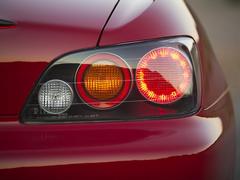 US gearing is different also. Gears one to four are all about four per cent lower geared, while fifth gear is just one per cent lower and sixth gear is two per cent higher.
US gearing is different also. Gears one to four are all about four per cent lower geared, while fifth gear is just one per cent lower and sixth gear is two per cent higher.
As a result, Honda says the US car now reaches 60mph in about 5.8 seconds; it was officially 6.2 seconds in North America before. The euro 2.0 litre accelerates like this already. Some US reviews suggests its performance is down on the previous generation S2K, recording 6.4 second to 60mph..
Part of the reason for the different US engine was said to be tougher US emission requirements such as California’s Low-Emission Vehicle (LEV) standards. Possibly another reason was that US drivers don’t like to change down so much and prefer mid-range grunt to a lower gear.
It all makes for a slightly less visceral car; a scalpel-like motor has had its blade blunted.
Space – but not time-saver -- tyre
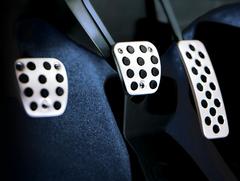 The S2K has a new wrinkle on space-saver spare tyres. Like many cars, it carries a space-saver as a way of increasing boot space. This is a pain when it’s needed as your car is half-crippled. But Honda has given S2K owners extra pain when there is a rear puncture.
The S2K has a new wrinkle on space-saver spare tyres. Like many cars, it carries a space-saver as a way of increasing boot space. This is a pain when it’s needed as your car is half-crippled. But Honda has given S2K owners extra pain when there is a rear puncture.
The limited slip differential cannot cope with a space saver rear wheel fitted to one side only. So drivers have to remove and fix two wheels to get home. So you replace a front wheel with the space saver wheel. Then replace the punctured rear wheel with the inflated front wheel. Put the punctured rear wheel in the 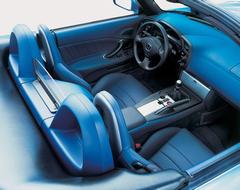 boot, which has a depression set into the floor for this purpose.
boot, which has a depression set into the floor for this purpose.
If the boot is full of luggage – two of you are away for a weekend - then that has to be removed to make space for the punctured tyre. So on a practicality count this car scores low – you might even say it’s flat.
When the puncture is repaired, replace the rear wheel with the repaired one and move the temporary rear wheel back to the front as the front and rear tyres are different dimensions.
Front punctures are fixed normally with only the front wheel needing to be removed and replaced.
A fair-weather car?
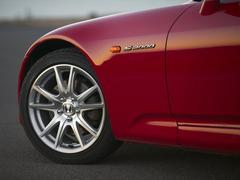 While being great value for its performance money, the S2K isn’t a great provider of storage space. Cabin stowage space is minimal. Hell, cabin space for two full size adults is minimal – and the boot is small; MX-5 users get a slightly bigger cavity. Boxster owners are better off; they get a comparatively vast boot in the front of their car.
While being great value for its performance money, the S2K isn’t a great provider of storage space. Cabin stowage space is minimal. Hell, cabin space for two full size adults is minimal – and the boot is small; MX-5 users get a slightly bigger cavity. Boxster owners are better off; they get a comparatively vast boot in the front of their car.
Hard-done-by S2K drivers also need to reckon on a potential need to store a punctured, full size wheel in the boot and, as a result of the potential need to carry it, there's an awkward shape to the boot cavity. You can lose most of the remaining space too, if you store the semi-rigid tonneau cover in it. If going 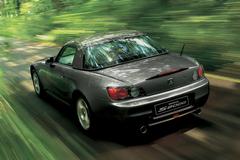 away two up, then you just have to leave the tonneau behind or get a boot lid luggage rack.
away two up, then you just have to leave the tonneau behind or get a boot lid luggage rack.
It’s not that great a sacrifice. If you are out driving and it starts raining then the six seconds needed to operate the powered hood turns into minutes if the tonneau is in place. Even longer if the boot has luggage in it. Think several long wet minutes while you unfasten the tonneau and re-stow the boot.
Conclusion
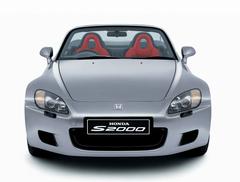 The S2000 is, like the Audi TT, a cleverly-designed car getting a lot of power out of a small package. You might wish for more sheer grunt at the low end and mid-range of the rev curve but that is not what is on offer. You get 150 mph performance and around six second 0-60 times plus a fantastically inspirational exhaust note at high revs and lotsa fun in the twisties.
The S2000 is, like the Audi TT, a cleverly-designed car getting a lot of power out of a small package. You might wish for more sheer grunt at the low end and mid-range of the rev curve but that is not what is on offer. You get 150 mph performance and around six second 0-60 times plus a fantastically inspirational exhaust note at high revs and lotsa fun in the twisties.
The S2K will more or less match an ordinary Boxster but is left behind by the S. It’s also way more affordable, Boxsters being £8-12,000 more. You get what you pay for with the S2K it seems, and what you get is a terrifically ingenious package with some flaws.
There are few other roadsters you can think of that fit the gap between MX-5/MGF and TVR/Boxster with 150 mph performance, tight handling, magnificent engine, a screeching wail of an exhaust at high revs and Honda’s bullet-proof reliability. What you don’t get is practicality. But at £8-12K cheaper than a Boxster, what the S2K has on offer is pretty good.
What is not on offer yet is an S2K S with traction control, a beefier engine and better steering wheel/seat adjustments, or an S2K with revised body shape enabling a full-size spare wheel and more cabin space. Honda has tweaked its basic package for Europe a couple of times and provided a more substantial tweaking for the US but there is no word yet on the model’s future.
Enjoy it while you can.
Previous stories:
www.pistonheads.com/roadtests/honda/HondaS2000.htm
www.autopress.be/Temporaires/SALON/GENEVE/Honda%20Concept%20HSC.jpg
www.winterink.nl/pictures/Downloads/HSC_Concept_2003_002.jpg
Accord Coupe V6 would be yummie . . .
http://motor.tuportada.com/img/wp/honda-accord-concept-13.jpg
www.motordesktop.com/wallpaper/conceptcars/Honda%20Accord%20Coupe%20V6%20Concept%202003%20-%201024x768.jpg
 Yeah I know it's nothing much . . . '95 with just a single carb. The last one. Like to see the 4pot with a proper set on.
Yeah I know it's nothing much . . . '95 with just a single carb. The last one. Like to see the 4pot with a proper set on.  But.
But. Everyone who drives it or sits next to me when I drive says: what a smooth ride / what a revelation compared to my Escort / Golf / whatever . . . etc. etc. City / highway driving that is. Almost like driving an auto for the lump is so forgiving, silent and stretchy. Chairs are good. Shifting is yum.
 When I step on it - like I did yesterday eve - I keep revs high (4500 - 7000) and shift up and down a lot. Like that very much and came home with a stif neck, no powersteering and all that. Hard work to make it move just a tiny bit compared to a Boxter or whatever . . . but hell it's so easy to spank some bigger cars . . . Passenger has to hold on firm and often they think there's a bigger lump in. No lie.
When I step on it - like I did yesterday eve - I keep revs high (4500 - 7000) and shift up and down a lot. Like that very much and came home with a stif neck, no powersteering and all that. Hard work to make it move just a tiny bit compared to a Boxter or whatever . . . but hell it's so easy to spank some bigger cars . . . Passenger has to hold on firm and often they think there's a bigger lump in. No lie. When you don't like revving, shifting and all that Honda is not for you. S2000 or Civic: same kinda philosophy is in all of these cars.

I would lie if I said there's nothing else than revving hard and clutch around. Few weeks back I thundered around in a 6pot Merc - nothing fancy - and that was easy peasy. One hand steering 40 mph 90 degree turns. Torque all over the place.
 over 100 mph - again! I'm waiting for those tickets . . . But still I just like to do some working out with a proper soundtrack
over 100 mph - again! I'm waiting for those tickets . . . But still I just like to do some working out with a proper soundtrack 
Neil_H said:
This is aside from the fact that performance-wise the S2000 and Boxster S aren't a million miles apart.
They're just different cars:
front vs mid engine
4pot 2 litre vs 2.7 litre B6
245 vs 275 something
Jap vs Pork
Sound vs ah, now that's subjective . . .
Name me a 4potter frontengine in the same price range that can top it . . .
'The S2000 engine and transmission are capable of accelerating the S2000 from 0-60 mph in less than six seconds. '
Gassing Station | Motoring News | Top of Page | What's New | My Stuff

